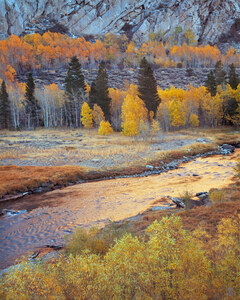
Rush Creek, autumn, Mono County, California
The Mono Basin lies between the crest of the Sierra Nevada at Yosemite and, roughly, the Nevada state line, with altitudes ranging from 6,372 feet to 13,053 feet. It is an area of great geological activity and considerable scenic splendor. Mono Lake, the oldest continuously existing lake in North America (500,000 years), sits at the bottom of the basin and is an endorheic lake, meaning it has inlets but no outlets. During the Pleistocene, there were several large lakes interconnected by streams in the high desert basins of eastern California. Since then most have dried up. Mono is an alkaline mineral lake, as opposed to a salt lake (primarily holding calcium carbonate and magnesium carbonate in solution as opposed to sodium chloride) and supports therefore a terrifically productive but very short food chain consisting basically of brine shrimp, brine flies, and birds. Only one other aquatic ecosystem in the world, a salt marsh in Borneo, has been studied and found to be more productive than Mono, acre for acre. The overwhelming majority of Mono's incoming fresh water, which balances off evaporation when the lake is stable, comes out of the Sierra, and Rush Creek is the largest of the few streams. Since 1941, however, Rush Creek and Lee Vining Creek, the second largest stream, have been diverted to Los Angeles, more for the money generated by letting the water flow downhill through turbines to make electricity, than for the water itself. As a result, the lake was drying up and headed for becoming too saline for the life it supports, before the momentous victory against the Los Angeles Department of Water and Power in the Supreme Court of California some years ago. Since then, water diversions have been reduced and a less-threatening balance of inflow versus evaporation has been maintained. Millions of birds depend on the lake for life in their great migrations. The water amounts to less than one part in 500 of that used in California.

